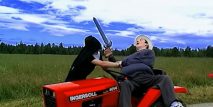Director: Michael Arell
Expected Rating: PG
Distribution: No known distribution
Budget: $0 (Due to Preowned Equipment and donations)
Genre: Comedy
Release Date: August 2017
Official Website: sleepydogfilmsusa.com
Trailer: Click Here
Online Version: Not currently available
Running Time: 82 minutes
Critique Issue: #133 (4/17)
Critiqued By: Manuel Crosby
Final Score: 3.1 (out of 10)
Slim (Michael Arell) is an overweight archaeologist who doesn’t seem to be going anywhere in his life… That is, until his boss sends him on a mission to find the mythical Golden Dustpan.
While Slim gets himself into far more trouble than he expected on his quest, he ends up learning about himself and who he wants to be in the world.
Content
In Slim, Arell seeks to capture a freewheeling, improvisational spirit with his story, dialogue and comedic situations. This does lead to a few chuckles, but unfortunately the lack of focus in his script often detracts from the film. The scenes seem loosely connected, and the stakes feel low. Midway through, I found that I could not remember why Slim was on his quest to begin with, and I lost interest. Raising the stakes in the script could help solve this. What exactly happens if Slim doesn’t find the Golden Dustpan? How much time does he have? Why does he need this journey to become a better man? Establish these details early on in the screenplay, and Slim’s quest could feel much more important to the viewer.
Furthermore, the performances, which felt mostly improvised, needed direction. (One book that MFM has recommended for a number of years on the art of directing actors is: John Badham On Directing ) Ad-lib acting only works when the actors understand the essence of their characters (and usually have years of experience with standup and improv), because they can then create spontaneous lines and actions that feel natural. This was not the case here. (Even the most successful ad-libs on film sets in Hollywood come on TOP of an already well-written script, not in place of it.)
When acting as both director and star, Arell needs to focus more on directing the other performers. For example, in a dialogue scene at a restaurant between Slim and his sidekick, Tubba (Michael Armstrong), Arell seems to understand more clearly his character’s motivation than Armstrong does. Something to consider for directors who plan on casting themselves in their own film: It can certainly be done (as Hollywood has proven), but it takes lots of focus and dedication to every cast member’s performance, not just one’s own. (Our editor brings up the fact that the only people in Hollywood who direct themselves are master actors who have built up a team of production people beforehand. Because of the smaller crews and general lower amount of experience, he’s gone so far as to say that it’s virtually impossible to accomplish this on a feature length microbudget film successfully as he discovered the hard way on his first feature. )
And also, judging one’s own acting while performing can be difficult. If the director plans to star in his own future films, I would highly recommend that Arell schedules more rehearsal time with the cast. Or, he could also bring on a trusted co-director to provide an honest opinion on the acting.
Visual Look
It is clear that there was an ambitious vision for Slim. However, a lack of expertise and equipment prevents the production team from meeting their goals.
Some of the locations were well chosen, like a wide-open field full of people enslaved by the Nunzonians (citizens of a fictional country in the film), yet the majority of scenes lacked set design. In one instance, this missing set design was attempted in post-production. During a static shot of Slim talking on a phone, a fruit bowl was composited into the scene, resting on the counter. However, the color and lighting of the composited fruit bowl did not match everything else. Furthermore, the bowl disappeared in the subsequent shot, where the camera moved. When adding elements digitally, filmmakers must make sure that those elements remain in the scene. This can be accomplished with motion tracking techniques, using many popular programs like Adobe After Effects and Hitfilm Pro. Lessons can be found online, but essentially these techniques will cause the digital items to appear to be a fixed part of the scene, regardless of the camera’s movement. As a warning, filmmakers should use an easy to see object (preferably chroma green or blue) with tracking marks on it as a substitute for the digital object, so that the tracking program can interpret the tracking data properly. Or, filmmakers could place small tracking marks on stationary surfaces in the scene, and remove them later. (Shameless plug: If you want to learn more about Green Screen compositing, our editor co-wrote a great beginner book, Green Screen Made Easy!)
Yet, all of this takes time; far more time than just placing a fruit bowl on the table to begin with! This reveals the lesson in no-budget set design: Good results start in the planning stages. If you don’t have a lot of money, find locations that already fit, or get creative and make the most of your resources to decorate the set in advance. Yet, when something cannot be accomplished at all due to budget, turning to VFX can be worth the time.
This film features very inconsistent cinematography- perhaps because it was shot over an eight-year period. The Sony TRV-340 Camera that was used does not hold up to the standards of modern high-definition. However, kudos to Arell for using the camera available to him at the time. Oddly, in a scene where Slim finally reunites with his love interest Snarion (Alissa Dubois), it appears the camera was set to record in an anamorphic setting, but the footage was not unsqueezed. The entire imaged looks squished. Fortunately, this would be an easy fix in the future. One can simply resize the footage in their editing suite, stretching it out to appear normal.
In several instances of the wide shots in the Nunzonian fields, use of an extremely wide aspect ratio emphasizes the size of the landscape and the crowd. However, I wish Arell had stuck with a consistent aspect ratio. The film jumps around from 4:3 to 16:9, and to even narrower and wider aspect ratios. This distracted me a lot. In the future, it would serve the film better to pick an aspect ratio and stick with it for the duration.
Furthermore, the shot selection and framing could use some improvement. At times, it felt like the filmmakers simply captured scenes with one wide shot because that is all they had time for. This leads to a less immersive experience. Added coverage would provide a wider variety to keep the visuals interesting. It would also create more options for editing, leading to scenes that don’t feel so slow. As a further example, during a scene where Slim fights villains while hanging onto a moving car, the camera’s framing reveals that the car is not moving at all. When shooting non-moving car gags, framing must be perfect and crop out all static background, or the illusion falls apart. Adding camera shake would also help sell the “motion” of the car. (Video-Copilot has a free tutorial on creating a motion car composite with a stationary car which would be a good idea to check out.)
There are a few instances of creative editing. During a fight scene, Arell cuts away to footage of a lightbulb being smashed, to emphasize the hits. This adds some visual comedy. He also uses stock footage of cityscapes and an airport interior to help further his story beyond the budgetary limits. As an improvement, this stock footage should actually be degraded to match the quality of the DV picture footage. In its current state, it appears to be shot on a totally different camera and breaks the illusion of continuity in the film. Recording the clips onto DV, then re-capturing, could help to solve this problem. After Effects plugins could also be added to help recreate the look of the original footage.
With that said, the overall film could have used tighter editing, as it felt much longer than necessary. (Having additional shots to cut between can help the edit be much tighter and prevent having Paul Thomas Anderson-style scenes that last way too long.)
Use of Audio
The music in the film was a slight improvement as compared to having no score. The synth orchestral score did not sound much like an actual orchestra, but at least the filmmakers had the idea of putting music in.
Overall, I could understand the dialogue. That said, it didn’t sound clean, as it would if it were well-recorded. When shooting dialogue-heavy projects, it is always good to use a shotgun mic at minimum. At the very least, I would start with a cheaper microphone and create a DIY boom pole using a painter’s pole. However, sound is always a good thing to pay a bit extra for, even with zero budget. While people will forgive low-quality camera images if the movie is interesting, bad sound will always throw them out. (I highly recommend reading the MFM article: Audio Tips That Every Microfilmmaker STILL Needs.)
There were times where the movie was obviously ADR’d. In one scene, the entire group of Nunzonia villains speaks German, badly dubbed and out of sync. This worked for comedic effect. However, near the end of the film, a line was added for an English-speaking character who spoke off-screen. Unfortunately, the quality of the sound was completely different than the lines that were recorded on camera. For micro-budget ADR, it is a good idea to record your ADR lines on the same microphone that you used for production. If the audio was all captured via a camcorder’s onboard mic, then I would suggest using that same camcorder to record added lines. This keeps the sound quality consistent. The ideal situation is to record in an audio studio or completely muffled room so that there’s no room tone and then adding the correct tone and reverb after the fact, but that takes better equipment and expertise than many starting filmmakers have access to. If a filmmaker don’t have access to these options, then the recording must be done in the same sort of environment that the original audio was recorded in so that the audio stays consistent. (Make sure to record room tone in the new location before and after the dialogue, so you can blend that with your other recording. More on room tone in the earlier Audio Tips article.)
Sound effects can add greatly to a film. Unfortunately, Slim lacked these elements, which hurt its believability. When Slim fights two nuns on the side of the road, there are no fight sounds, which draws attention to the fact that his punches are not connecting. (If you can’t afford the more costly audio sound effects bundles, there are now archives like FreeSound.org which have a lot of effects free of charge.)
Furthermore, the movie lacked any intentional background sounds (called “sound design), which further hurt its feeling of authenticity. Adding subtle effects like birds, winds, or street noise will help sell the film as reality.
Use of Budget
$0 is the dream expense report for us microbudget filmmakers. Yet, it rarely happens this way.
Arell found a way to make this a reality. He called in favors from family and friends, used the camera he already owned, wrangled food donations, and got volunteers to help both in front of the camera and behind. This type of resourcefulness will go a long way in helping Arell get his future productions made, as it’s a great skill to have as a growing filmmaker!
That said, I do feel that a small amount of money spent would have greatly improved the quality of this film. First off, investing in good sound equipment would strongly aid Arell–and any microfilmmaker. Unlike camera technology, sound recording does not evolve as fast, so the money you spend is a better investment. Good quality recordings will sound good forever- they’re future proof!
Additionally, the largely non-monetary budgeting of time to fully refine the script for the film and more time to cast/rehearse will likely keep the actual monetary budget low while resulting in a much more successful end product.
Lasting Appeal
While I commend Arell and company for jumping into the world of feature film production, the end product does not have much lasting appeal on its own. The story, acting, and the technical qualities are far too rough to result in an entertaining film for the average viewer. It will mostly be enjoyed by those who helped with the film.
Overall Comment
Slim was clearly a learning experience for its director, and a chance for a group of friends and family to create something together without any budget whatsoever. The team deserves congratulations for seeing it through. But unfortunately, the wide range of problems within Slim results in an end product that doesn’t work well for average viewers. I’m sure Arell will use this film as an educational opportunity, allowing him to greatly improve with his future efforts!
|
Breakdown
|
|
|
Content
|
2.0 |
|
Visual Look
|
2.0 |
|
Use of Audio
|
3.0 |
|
Use of Budget
|
7.5 |
|
Lasting Appeal
|
X.X |
|
Overall Score |
3.1 |
| How do we critique films? Click Here To See. | |






